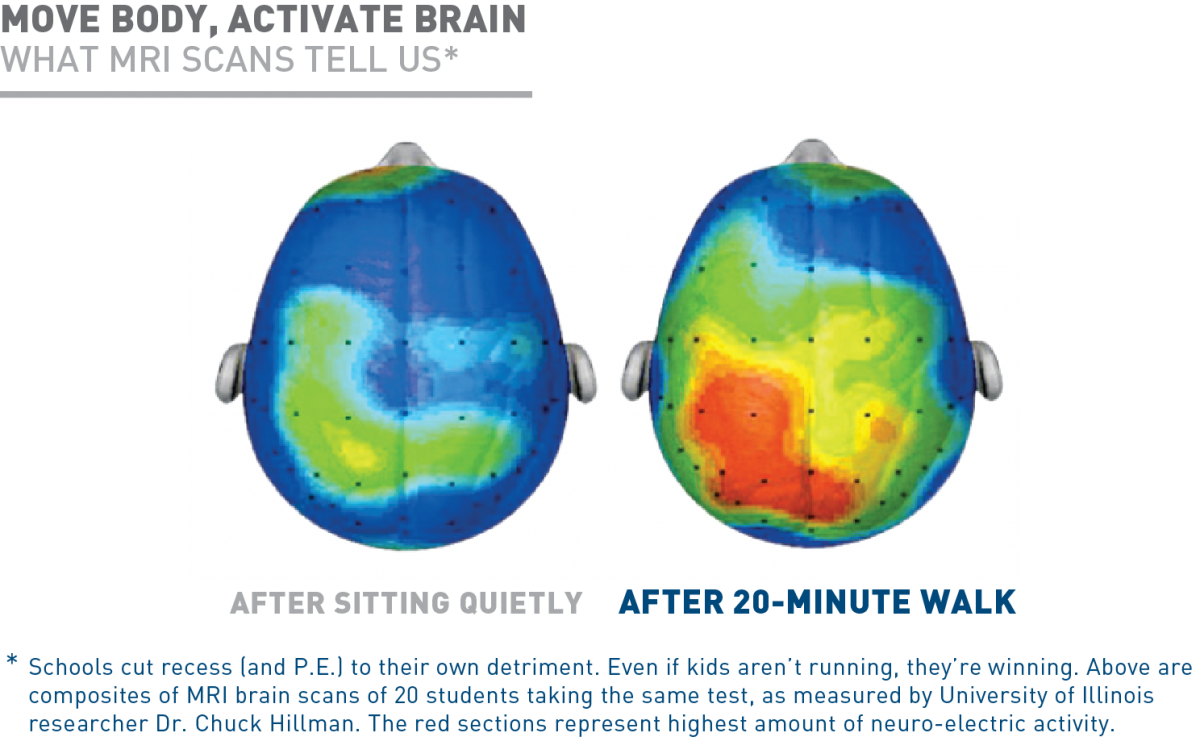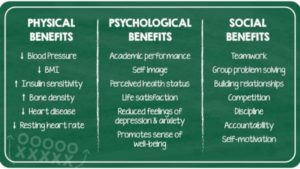Regular physical activity benefits health in many ways, including helping build and maintain healthy bones, muscles, and joints; helping control weight and reduce fat; and preventing or delaying the development of high blood pressure (GAO, 2012). Exercise is one of the least expensive ways to stay healthy, with one study finding that exercise can prevent chronic diseases as effectively as medication (British Journal of Medicine, 2013). A comprehensive study and analysis of existing research found that leisure-time physical activity is associated with reduced risk of 13 different types of cancer, including breast, colon, liver and myeloid leukemia (National Institutes of Health, 2016).
Sports participation is a significant predictor of young adults’ participation in sports and physical fitness activities. Adolescents who play sports are eight times as likely to be active at age 24 as adolescents who do not play sports (Sports Participation as Predictors of Participation in Sports and Physical Fitness Activities in Young Adulthood, Perkins, 2004). Three in four (77%) of adults aged 30+ who play sports today played sports as school-aged children. Only 3% of adults who play sports currently did not play when they were young (Robert Wood Johnson Foundation/Harvard University/NPR, 2015).
Obesity reduction. In a 2014 study published in the American Journal of Preventive Medicine, researchers analyzed obesity prevention strategies and their ability to reduce obesity by the year 2032. They found afterschool physical activity programs would reduce obesity the most, 1.8% among children ages 6 to 12. That’s twice the projected impact as any ban on child-directed fast-food advertising. An earlier study of college students found that “motives for sport participation are more desirable than those for exercise and may facilitate improved adherence to physical activity recommendations” (Kilpatrick, Journal of American College Health, 2005).
But the obesity epidemic continues. In 2018, a study published by the American Academy of Pediatrics showed overweight and obesity rates increased in all age groups among children ages 2 to 19 (Prevalence of Obesity and Severe Obesity in U.S. Children, 1999-2016). The rates generally increased with age, with 41.5% of teens being obese by 16 to 19 years old. Of particular concern were continued racial and ethnic disparities. White and Asian children showed significantly lower rates of obesity than Hispanic and African-American children. Researchers also found a sharp increase in obesity from 2015 to 2016 compared to the previous cycle among children ages 2 to 5, especially boys. Girls 16 to 19 years old had a notable jump in overweight rates, from 36% in 2013-14 to 48% in 2015-16. Youth who have disabilities are 4.5 times less active and have obesity rates that are 38% higher than other youth (Physical Literacy in the United States: A Model, Strategic Plan, and Call to Action, 2015).
Not enough children are active. A 2018 study from Nationwide Children’s Hospital showed that just 5% of youth ages 5 to 18 reported meeting the federally recommended amount of exercise — 60 minutes per day. The study, which examined 7,822 children over three years, also found that 50 percent were insufficiently active and 5 percent reported no physical activity. Researchers recommended that pediatricians should treat exercise like a vital sign, similar to height and weight, and engage patients in conversations about how to be more physically active. A 2020 study found that 60% of American children had inadequate levels of cardiorespiratory fitness, putting them at increased risk of chronic diseases at younger ages (American Heart Association, 2020). The Aspen Institute’s Healthy Sport Index is a tool that can help parents find the best sport for their child based on health benefits and risks. The resource includes original research that found boys generate more vigorous physical activity at high school practices than girls (North Carolina State University, 2018).
EDUCATIONAL BENEFITS

From the Sport for All, Play for Life report. click to enlarge
Organized sports activity helps children develop and improve cognitive skills, according to a study that tracked kids from kindergarten through fourth grade (Piche, 2014). Physical activity in general is associated with improved academic achievement, including grades and standardized test scores. Further, such activity can affect attitudes and academic behavior, including enhanced concentration, attention, and improved classroom behavior (GAO, 2012).
High school athletes are more likely than non-athletes to attend college and get degrees, and team captains and most valuable players achieve in school at even higher rates (U.S. Dept. of Education, 2005). Also, high school athletes are more likely to expect to graduate from a four-year college (73% girls, 59% boys) compared to non-athletes (67% girls, 53% boys), according to data collected for the Healthy Sport Index (Women’s Sports Foundation, 2018). A higher percentage of high school athletes also receive A/A- grades than non-athletes (Women’s Sports Foundation, 2018).
The benefits extend to the workplace. A survey of 400 female corporate executives found 94% played a sport and that 61% say sports contributed to their career success (EY Women Athletes Business Network/espnW, 2014).
PSYCHOSOCIAL BENEFITS
A correlation has been found between regular exercise and mental health among students in general as they move into the teenage years. Among students who exercised six to seven days a week, 25.1% felt sad for two weeks or more in the past 12 months, compared to 35.7% of students who reported exercising on zero to one day (Women’s Sports Foundation, 2004). Of students who exercised six to seven days, 15% reported suicidal ideation, and 6.4% reported a suicide attempt in the past year, compared to 24.6% and 10.3% of students who exercised zero to one day, respectively (Journal of American Academy of Child & Adolescent Psychiatry, 2015). A 2019 study found that children who reported no exercise were twice as likely to have mental health problems, particularly related to anxiety and depression, compared with those who met the recommendation of an hour a day, and a 2020 study suggested that the more physical activity teenagers participated in, the less likely they were to report depression as 18-year-olds (The New York Times, 2020).
Physical activity, and sports in particular, can positively affect aspects of personal development among young people, such as self-esteem, goal-setting, and leadership. However, evidence indicates that the quality of coaching is a key factor in maximizing positive effects (GAO, 2012).
Both male and female high school athletes are less likely to smoke cigarettes and suffer from loneliness and low self-esteem, when compared to non-athlete peers, according to research used for the Healthy Sport Index (Women’s Sports Foundation, 2018). High school athletes, though, are more likely to binge drink alcohol, with youth in contact sports (football, lacrosse, wrestling) showing the riskiest off-field behavior).

